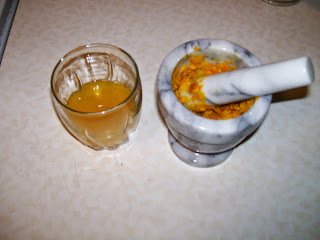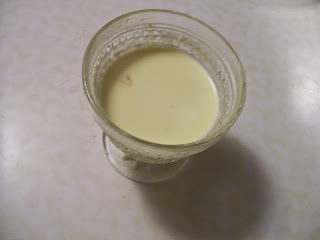The Challenge: Orange-flavored, orange-colored... anything "orange."
The Receipt: Orange Custard from The Cook's Own Book and Housekeeper's Register by Mrs. N. K. M. Lee
ORANGE CUSTARD. Having boiled the rind of a Seville orange very tender, beat it in a mortar to a fine paste; put to it the juice of a Seville orange, a spoonful of the best brandy, four ounces of loaf sugar, and the yolks of four eggs; beat them all well together ten minutes, then pour in by degrees a pint of boiling cream; keep beating it till cold; put it into custard glasses. Set them in an earthen dish of hot water; let them stand till they are set, then stick preserved orange, or orange chips, on the top. It may be served hot or cold.
Year/Region: 1842, American (Boston)
How Did You Make It: Boiled the rind of 1 navel orange (change from original receipt) for c. 30 min, topping off the water as needed. Ground the peel into a paste with the mortar & pestle, then mixed it up with the juice of the orange, 1 Tbsp brandy, just under 4 oz of granulated sugar, and 4 egg yolks. Continued beating with the mixer while bringing 1 pint of cream to boil, and continued mixing while adding the cream, and allowing the mixture to cool. Poured into glasses and place in a pan of warm water to set.
(It didn't actually set during the first hour, so I moved one of the cups into the refrigerator; none have set as of 7 hours later--usually, this means I didn't boil something long enough).
Time to Complete: About half an hour to soften the peel, and a little under another half hour to mix up the ingredients. Setting time unknown, as it didn't actually set.
Total Cost: $4.50-ish, with sugar and brandy on hand.
How Successful Was It?: Tasted fine--a light orange flavor, rich with cream and rather sweet (but not overwhelmingly so). The only problem was that it's still liquid rather than custard. Might try freezing it.
How Accurate Is It?: I used granulated sugar for loaf sugar, as usual. More pertinently, Seville oranges apparently aren't in season at the moment, so I used a navel orange instead. According to the internet, Seville oranges are notably tart--even to the point of being compared to lemons--so I skimped slightly on the 4 oz of sugar to make up for the sweeter orange. Not having custard glasses (which seem to be stemmed glasses with handles), I substituted breakfast glasses and champagne coupes.
 |
| Step 1 went all right: juicing an orange and mashing the peel. |
 |
| Custard tasted yummy, but didn't reach the desired consistency. |

Oh I would have loved to see this one out nice as it sounds delicious! Isn't it funny how modern inventions like 1/2 teaspoon of cornstarch would have set that up in a minute!
ReplyDelete…corn starch was very much a thing they could have used— the problem here is probably the lack of sugar, actually.
DeleteI'll have to try that next time. I did end up sticking one in the freezer, with delicious results.
ReplyDelete